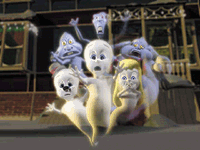Michael Hurwicz investigates the ways some animated properties have been able to rack up big licensing and merchandising success without the usual exposure of television or a feature film release.

Toy Story 2 -- another example of Disney's merchandising success. © Disney Enterprises, Inc. and Pixar Animation Studios. All Rights Reserved.
When Disney starts developing a new feature, toy manufacturers and other merchandisers line up and lay down big bucks for licensing rights. A popular kids' TV program generates the same kind of interest. Media success breeds success in licensing and merchandising -- this is not a secret.
And while this is great news for all those properties going into development at Disney, what if you have a property that has licensing potential, but you don't happen to have a deal with Disney or a top-rated show on Nickelodeon? Potential licensees don't want to talk to you, because they know that kids buy what they see on TV and in the movies. As a result, independents shopping a property often don't think much about licensing until they've landed a media deal.
That could be a mistake. There are strategies that can lead to success in licensing that don't depend on already having a media hit. In fact, these strategies can lead to success in the media, too.

In the driver's seat, Michael Paraskevas,illustrator of The Tangerine Bear. Photos © Michael Paraskevas.
Plush is a Plus
One basic idea, when it comes to toys, is "think plush." While a typical molded plastic figure takes eighteen months to get from conception to toy store shelves, a plush toy can make the journey in six months or less. Plush toys don't require huge, expensive molds. They are unlikely to cause injuries. And there are certain types of plush toys, such as teddy bears, that are perennially in demand, with no TV shows or movies to back them up. In every way, they're low-risk.
Plush potential is no guarantee of success. But if plush does fit your project, it's definitely an advantage as you pursue other strategies.

Another fun Paraskevas creation, Maggie and the Ferocious Beast. © Nelvana.
The Tangerine Bear, a special being aired this Christmas season on ABC, has demonstrated this advantage twice.
Tangie-ble Results
"Tangie," as some of his friends call him, started life in 1997, in a children's book. Tangie's creators already had a track record in print media. In addition, mother and son team Betty and Michael Paraskevas, author and illustrator, were talking to Nelvana about another book-based property, Maggie and the Ferocious Beast, which has since gone on to top the charts on Nick Jr., after its debut in the summer of 2000.
Tangie, however, was a new character, with nothing but his touching story and sad expression to recommend him. Being a teddy bear, however, has its advantages, and a plush Tangie was able to make an appearance in bookstores alongside the HarperCollins hardbacks that told his tale.
"It was a great bear, and it sold out," says Michael Paraskevas.

Success can start with a storybook. The Tangerine Bear by Betty Paraskevas and illustrated by Michael Paraskevas. © Storyopolis.
Wait, there's more: He'll be on hand at mall events across the country, which will include special screenings for kids, as well as photo ops of kids donating money to the Starlight Children's Foundation, a non-profit that provides entertainment for hospitalized kids. Tangie will also be the star player in "bear drops" that Starlight will do in hospitals. Artisan is donating fifty cents to Starlight for every video sold. The deal is similar to one that brought in over a million dollars for the Make A Wish Foundation and helped make Annabelle's Wish the number three selling video in 1997, under Ross' guidance at Hallmark.
The Power of Print
In addition to demonstrating the pluses of plush, The Tangerine Bear illustrates the power of print -- it's a lot easier to get a start in bookstores than in movies or TV.
Print media other than books can also serve as a base for media and licensing success. And you don't have to have a once-in-a-century juggernaut like Peanuts to make this strategy work for you.

For instance, Martha Montoya, creator of the Latin-flavored Los Kitos comic strip, started building a base in newspapers in 1995. Today, the strip appears in 305 publications in the U.S., Mexico and 15 other countries. From comics, she went into radio, creator, where she became creator, producer and actor in "RadioKito" on the Hispanic Broadcast Corporation (HBC).
From this base, Montoya has snagged some licensing deals involving big names. For instance, Bank America Corp., State Farm Insurance and the Department of Agriculture have all used the Los Kitos characters when they wanted to reach a Hispanic market. Sears Roebuck & Co. features Los Kitos characters on a line of children's clothing. Wal-Mart started selling a line of Los Kitos shoes in 1999.
All this is without any TV or movie exposure. Meanwhile, the Krislin Company has acquired animation rights to Los Kitos. At last report, they hoped to bring an animated series to the television market in the year 2000. While shopping the property for broadcast, Krislin is also developing straight-to-video releases.
Not quite a "rags to riches" story -- yet. But that's the whole point.
"Don't wait for miracles," advises Montoya. "Build a business. Pay the bills. Build a reputation. They'll eventually come to you."
Think Bits
Even easier to get into than print is the Internet. However, most observers agree with Lina Maini, president and chief operating officer of Mainiac Productions and CEO of Howlin Entertainment:

Casper's Haunted Christmas creators, Harvey Entertainment, are striking into new territory by acquiring Walter Miller's Home Page. © Harvey Entertainment.
"The Net is more a marketing tool now than its own form of media. It's easy to copy Internet content, and electronic rights is still a new field. That combination makes it hard to protect proprietary material. I view the Internet as adding exposure, but I wouldn't launch there."
However, there's always the exception that proves the rule. In what may be a first, Harvey Entertainment, of Casper, the Friendly Ghost fame, has licensed the rights to "Walter Miller's Home Page" and is shopping it as a primetime animated TV series. Prior to being licensed by Harvey, "Walter Miller's Home Page" had a presence only on the Internet, where it is one of the longest-running and worst-spelled comedy sites, with a fanatical cult following.
"The success on the Website gives us a definite competitive advantage when pitching the show," says Rick Mischel, president of Harvey.

Julie Aigner-Clark, CEO and founder of Baby Einstein, with her two girls. Photo © 2000 The Baby Einstein Company LLC. All Rights Reserved.
Think Niche
The Net provided a safe haven for "Walter Miller's Home Page" until it achieved a following that propelled it toward the big time. Similarly, Montoya has built a following in a niche that the big players largely ignored, and where her Latino roots gave her special insight. (Montoya came to the U.S. from Bogota, Columbia, at age 25.)
Niche marketing is a time-honored strategy that comes in a thousand flavors. Julie Aigner-Clark, for instance, got her special insight from motherhood. Aigner-Clark's first success in media was Baby Einstein, a video of music and nursery rhymes in English, German, Russian, Spanish, Hebrew and French. The theory, backed by academic research, is that exposing infants to foreign languages makes it easier for them to learn languages later in life. There's no indication that they learn specific words, much less syntax. More likely, hearing the phonemes stimulates the brain to be able to process those phonemes. Visuals, including brightly colored objects and toys, as well as black and white patterns, keep the infant focused on the video.

Just a few of the many colorful and exciting products from Baby Einstein. © 2000 The Baby Einstein Company LLC. All Rights Reserved.
Aigner-Clark ran across the research that inspired Baby Einstein in 1994, when she was pregnant with her first daughter, Aspen. During 1996, using a borrowed Betacam, she shot the video in her basement. She edited it on a home computer using Adobe Premiere.
The Baby Einstein video was completed in early 1997. Initially, Aigner-Clark sold the video through specialty retail outlets, such as Babies R Us, Toys R Us, Imaginarium, Noodle Kidoodle, Store of Knowledge, The Right Start and Zany Brainy. She also used Internet sites like Amazon.com.
The project grossed $100,000 in 1997, on an investment of $15,000. In 1998, with two titles, sales totaled $1 million. The third year, they did $4.5 million, all without a shred of TV exposure -- and no advertising of any sort.
"It was all word of mouth," says Aigner-Clark.

Baby Einstein's holiday offerings include a special CD and video. © 2000 The Baby Einstein Company LLC. All Rights Reserved.
They project $10 million in sales in 2000. The total employee count is now six, including Julie and her husband, Bill. They still work out of their home. They use a number of distributors, including Artisan Home Entertainment, which purchased 20% of the business. They've expanded their product line with more Baby Einstein videos and other lines such as Baby Mozart. As of September, 2000, the Baby Einstein Company was working on three licensing deals, in toys, publishing and apparel. All three, independently, came to Aigner-Clark, who had been too busy minding the store to go looking for them.
Aigner-Clark's advice: "Focus on one thing. Build something fabulous and make it very strong on its own. Then you'll have the opportunity to grow."

Phil Vischer, Big Idea's founder and CEO, as well as the voice of Bob the Tomato. Photo © 2000 Big Idea Productions.
"My Way"
Strategies such as those pursued by the Paraskevas, Montoya and Aigner-Clark provide a solid base that allows you to maintain the integrity of your product. For instance, Big Idea is a production company that makes VeggieTales, videos that teach Christian values to kids using animated vegetables.
The company was founded in 1993 by Phil Vischer, a computer animator and storyteller. He started in a spare bedroom, as the Big Idea Website explains, with one computer, little capital and no connections.
The first half-hour episode of VeggieTales, "Where's God When I'm S-Scared?" was released before Christmas, 1993. It sold 130,000 units through 1995, 750,000 by the end of 1996, and passed the two million mark in 1997. Initial marketing was almost entirely through Christian bookstores.
In the midst of this spectacular growth, Big Idea was approached about putting VeggieTales into mass market outlets like Target, Wal-Mart and K-Mart. They loved the idea. There were just one or two problems.
"They wanted us to change it," recalls Diane Teigiser, Big Idea's toy and licensing maven. "Take out the Bible verse at the end. Take out the God reference."

Right out of the produce section and onto video, these good looking vegetables have helped make Big Idea a huge success. © 2000 Big Idea Productions.
For some reason, Phil didn't want to do that.
"A year or two later," says Teigiser, "they came back and said, 'Okay, leave the God in, but take the Bible verse out.'"
Phil still refused.
Early in 1998, VeggieTales passed the two million mark. "We got so successful, they said, 'We'll take it just the way it is,'" says Teigiser.
By the end of 1998, they passed the three million mark. Today, Christian spokesmodels like Bob the Tomato, Larry the Cucumber and Mr. Lunt, the decorative gourd, have sold over 20 million videos, and employ over 130 people.
On the creative front, Big Idea has expanded into space penguins. On the commercial side, they've got books and music. Fisher-Price/Mattel and Learning Curve International have licensed VeggieTales for toys. Hallmark Cards has licensed it for stationery, gifts, greeting cards and party goods. Other licensees use VeggieTales characters on children's pajamas, shoes, bed and bath products, clothing and accessories. Still others make VeggieTales fabrics and wallpaper borders, cardboard puzzles and board games, dinnerware, cake decorations and balloons.
Big Idea still has little or no media exposure and operates almost exclusively direct-to-video.

© Storyopolis.
Doing the Right Thing
The Paraskevas are going through a similar process with "Jr. Kroll," Betty's favorite among her own characters, as she's demonstrated by writing four books about him. She sees Jr. Kroll as a primetime TV show, in the same class as The Simpsons. Major studios have shared that vision. But there are always one or two problems, as Betty explains: "They ask, 'Can we get him out of the double-breasted blue suit?' I say, 'No. Jr. doesn't give in to peer pressure.' They ask, 'Can we give him a Hispanic nanny?' I say, 'No. He doesn't have a Hispanic nanny. He's already in four books and a toy in FAO Schwartz, and there's no Hispanic nanny. You can't spoil my character.' About that time, I get up and walk out."
The Paraskevas were doing just fine with children's books (supplemented by the occasional toy) before they ever started talking to the studios. That makes it a lot easier to do the right thing rather than the easy thing when the pressure is on.
Protect Yourself
One disadvantage of the strategies discussed in this article is that you don't have the muscle of a big media company's legal department behind you. It's important, whether you get your projects out through books, comics, radio, the Internet, or direct-to-video, not to send them into the wide world unprotected.
"I've been hurt by being a trusting person," says Aigner-Clark, "thinking that everybody was going to be okay, and that people don't steal people's ideas. It's happened to us."
"Be careful who you deal with," advises Howard Leib, a Manhattan-based attorney specializing in children's entertainment. "Mass mailings of your project to people in a directory is not a great idea. Get references. Find out who they've worked with, what they've done. Find out if they're reputable. It's easier to protect yourself up front than have to fight down the line."
And register your trademarks and copyrights, adds Leib. A copyright costing only $30 can protect a collection of works. At $325, trademark registration is more expensive, but still within reach for nearly anyone.
When asked what final words of wisdom he would offer to fledgling creative entrepreneurs in children's entertainment, Michael Paraskevas' immediate response: "Get a lawyer." (He did laugh, but there was an edge to it...)
Lawyers can be costly. However, as Leib points out, you can always find out how much it will cost you to get a lawyer, but you never know how much it will cost you not to get one.
Michael Hurwicz believes in fairy tales, cartoons, music, trees and chocolate.








